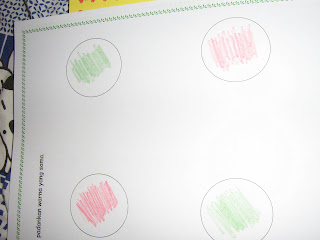Thursday, October 22, 2009
Alat bantu untuk melaksanakan aktiviti pengamatan penglihatan.
Wednesday, August 26, 2009
Effective Teaching Aid

The effective teaching aid that I see in PBS is Carta KIA2M. In order to help student that involve with KIA2M, this carta had been provided by government with CDs and books to all the primary schoolsin Malaysia.
Usually, we will think by our own how to help those children efficiently. The way that we think may be just able to help those children but not effectively. Therefore, we can use the way we think and modify it according to the teaching aid that provide by government. Besides, we also can use the CDs that provide by government. By using those CDs, we can attract them easily to what they should learn. This is a effective teaching aid for children that involve with KIA 2M.
Thursday, August 6, 2009
Flannel Board



Flannel Board
Dengan menggunakan “flannel board”, kami telah merekakan satu pengajaran yang akan diajarkan kepada murid-murid pemulihan. Kami akan menggunakan konsep keserupaan untuk mereka topik yang ingin kami ajar. Setelah pengajaran, kami akan membantu murid untuk mengimbas kembali pelajaran yang telah mereka pelajari. Selepas itu, murid-murid perlu melakukan diskrisminasi ke atas pelajaran yang telah mereka pelajari.
Topik yang akan kami ajar ialah peralatan dapur. Peralatan dapur yang kami pilih ialah “cawan” dan “gelas”. Dua perkataan tersebut merupakan suku kata KVKVK. Guru akan membimbing murid mengecam dua alat tersebut dan mengenal dua perkataan tersebut. Selepas itu, mereka akan belajar menyebut dua perkatan tersebut.
Seterusnya, guru akan membimbing murid membezakan cawan dan gelas iaitu melakukan diskriminasi.
| cawan | gelas |
| Ada pemegang | Tidak ada pemegang |
| Rendah dan lebar | Tinggi dan sempit |
| Mengisi milo panas | Mengisi susu suam atau minuman sejuk |
| Diletak di atas piring kecil | Tidak diletak di atas piring kecil |
Selepas itu, guru akan memberi contoh gambar cawan dengan milo dan gelas dengan susunya. Akhirnya, guru akan membantu murid untuk mengimbas kembali pelajaran yang telah mereka ikuti. Dengan itu ujian diagnostik dijalankan untuk menguji sebanyak mana murid mengingati pelajaran yang telah diajar. Pengajaran dengan melibatkan pengamatan penglihatan dan pendengaran menarik minat murid dan seterusnya membantu pengukuhan murid terhadap pengajaran yang telah dijalankan.
Saturday, July 11, 2009
Project Based Learning(PBL)
Definition of Project Based Learning(PBL)
Project-based learning (PBL) is typically has a time line and milestones which a model for classroom activity that shifts away from the classroom practices of short, isolated, teacher-centered lessons and instead emphasizes learning activities that are long-term, interdisciplinary, and student-centered. Project-Based Learning also is an individual or group activity that resulting in a product, presentation, or performance.
Project-Based Learning brings together intellectual inquiry, rigorous real-world standards, and student engagement in relevant and meaningful work. It is a comprehensive instructional model in which project work is central to student and instead of sharing much in common with Process Writing.
There are six step version of Process Writing as below:
- brainstorming
- organizing the brainstormed ideas
- developing a draft
- obtaining feedback
- revising, which may involve going bask to earlier steps
- publishing
The Basics of Project-based learning (PBL)
Project-based learning is an instructional model for classroom activity that involve students in investigative activities, problem-solving, design, and decision making. This model of instruction allows the opportunity for students to work autonomously over significant amounts of time and often culminates in realistic presentations or products.
Additionally, project-based instruction differs from traditional inquiry by its emphasis on students' own artifact construction to represent what is being learned.
Students pursue solutions to nontrivial problems by:
- making predictions
- collecting and analyzing data
- asking and refining questions
- drawing conclusions
- debating ideas
- designing plans and/or experiments
- communicating their ideas and findings to others
Characteristics of PBL
i. Learning is student centered.
ii. Teachers are facilitators to students.
iii. Learning occurs in small student groups.
iv. Problems for the organizing focus and stimulus for learning.
v. Problems are a vehicle for the development of clinical problem-solving skills.
Process of PBL
1) Students confront a problem
2) In groups, students organize knowledge and attempt to identify the nature of the problem.
3) Students pose questions of what they do not understand.
4) Students design a plan to solve the problem and identify the resources they need.
5) Students begin to gather information as the work to solve the problem.
What are the benefits of Project Based Learning?
![]() Provides a means for transferring, in whole or in part, the responsibility for learning from teachers to students.
Provides a means for transferring, in whole or in part, the responsibility for learning from teachers to students.
![]() Allows students to try out new skills and model complex behaviour in a non-threatening fashion.
Allows students to try out new skills and model complex behaviour in a non-threatening fashion.
![]() Prompts students to collaborate while at the same time supporting self-directed learning.
Prompts students to collaborate while at the same time supporting self-directed learning.
![]() Shifts students away from doing only what they typically do. For example, projects provide the means to give followers the experience of being task leaders.
Shifts students away from doing only what they typically do. For example, projects provide the means to give followers the experience of being task leaders.
![]() Offers multiple ways for students to participate and to demonstrate their knowledge.
Offers multiple ways for students to participate and to demonstrate their knowledge.
![]() Offers a learning experience that draws on the thinking and shared efforts of several individuals.
Offers a learning experience that draws on the thinking and shared efforts of several individuals.
Thursday, July 9, 2009
Hero - Jesus Christ
God loves us and offers a wonderful plan for our life.
God had created us. He loves us. He knows all things about us. He knows what actually we need. He had planned each of our life. Actually, we are very near to Him, but because of our sins, we had been separated from Him.He Died in Our Place
"God demonstrates His own love toward us, in that while we were yet sinners, Christ died for us."
He Rose From the Dead
"Christ died for our sins...He was buried...He was raised on the third day."
He Is the Only Way to God
"Jesus said to him, 'I am the way, and the truth, and the life; no one comes to the Father, but through Me."
His Son, Jesus Christ, die on the cross in our place to pay the penalty for our sins.
So, He is our hero!!
He is so mighty and great!Jesus Christ has sacrificed and suffered only because He loves us.His great love, His power love!
He is our saviour!!! He is our hero from first to last, from now on till the end of the world!
Hallehujah!
Thursday, July 2, 2009
Behaviourist Theory- WATSON, PAVLOV DAN THORNDIKE
WATSON, PAVLOV DAN THORNDIKE
1. J. B. Watson
Watson studied most of about the behavior of animal sand. He was much influenced by Ivan Pavlov. Watson said that behaviorism is a flawed basic assumptions about man and his relationship to the environment which have been accepted government and members of the powerful "scientific community".
In publishing Behavior, Watson hoped to achieve a wider popular circulation for his ideas which he hoped to infiltrate behaviorism into the introductory laboratory and the classroom. Watson succeeded in reaching those who were most open to change through this first textbook and through succeeding texts, Psychology from the Standpoint of a Behaviorist.
2. Ivan Pavlov
Classical conditioning which is a form of associative learning. Popular forms of classical conditioning that are used to study neural structures and functions involve eyeblink conditioning, the foot contraction conditioning of Hermissenda crassicornis and fear conditioning. For inducing classical conditioning, the typical procedure includes presentations of a neutral stimulus with a stimulus of some significance.
In his initial experiment, the dogs started to salivate in response to the metronome. Thos was due to Pavlov used a metronome to call the up dogs to their food. So, a neutral stimulus (metronome) became a conditioned stimulus (CS) while the unconditioned stimulus (US) is the meat powder.
3. Edward Thorndike
Edward Thorndike set out to apply "the methods of exact science" to educational problems by emphasizing "accurate quantitative treatment of information". "Anything that exists, exists in a certain quantity and can be measured" (Johcich, as cited in Rizo, 1991).
Connectionism-learning:
-the formation of a connection between stimulus and response.
The "law of effect" :
-when a connection between a stimulus and response is positively rewarded it will be strengthened and when it is negatively rewarded it will be weakened. Negative reward, (punishment) did not necessarily weaken bonds, and that some seemingly pleasurable consequences do not necessarily motivate performance.
The "law of readiness" :
-because of the structure of the nervous system, certain conduction units, in a given situation, are more predisposed to conduct than others.








